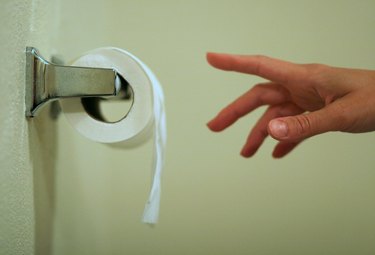
Ever wonder what happens after you devour your lunch? After all the savoring, chewing and swallowing (aka mechanical digestion), it's time for the breakdown of food — or chemical digestion — in the stomach and intestines. Here's what chemical digestion is and how it works.
The entire digestive process is aimed at "breaking down foods into their individual macronutrients," says New York City-based Samantha Gitlin, RD, CDN, a registered dietitian and certified dietitian nutritionist with Lenox Hill Hospital. Translation: Digestively speaking, a sandwich is not just a sandwich. It's protein, fats and carbohydrates (aka macronutrients).
Video of the Day
Video of the Day
"But when we eat," Gitlin says, "there are two forms of digestion that are activated within seconds of food entering our mouths" — mechanical digestion and chemical digestion.
Mechanical vs. Chemical Digestion
"Mechanical digestion is essentially the physical form of digestion," Gitlin says, "and it begins when our teeth and tongue help to grind and break down food into smaller pieces" — technically termed a bolus.
"So what we're talking about here is chewing our foods, mashing them up in our mouths and swallowing them," says registered dietitian and senior clinical nutritionist Samantha Heller, RD, CDN, of New York University Langone Health.
Swallowed food then gets moved along through the gastrointestinal tract by means of peristalsis, essentially small muscle contractions, according to the National Institute of Diabetes and Digestive and Kidney Diseases (NIDDK). This process "is what helps to slowly push food through the esophagus," Gitlin says.
The esophagus is the pathway that links the throat to the stomach, per the University of Michigan (UM). And it's the stomach — a muscular organ crafted to hold food in place — where chemical digestion largely takes over.
"Chemical digestion involves the release of various substances, called enzymes, from different body parts to break down the specific macronutrients into absorbable particles," Gitlin says.
"So, in a sense," Heller says, "this part of the digestive process is basically the unravelling of food down to its basic molecules so our body can properly distribute the nutrients out to all of our organs and cells."
To be sure, the two processes are certainly not walled off from each other — both Gitlin and Heller stress that, as a practical matter, mechanical digestion and chemical digestion overlap.
For example, Gitlin says, "food is not able to simply be pushed through the gastrointestinal tract by peristalsis alone," as a certain amount of chemical digestion takes place in the mouth even while food is still being chewed. "Our salivary glands release salivary amylase, which helps to initiate the digestion of carbohydrates," she says.
On the other hand, even after food hits the stomach, "there's definitely still some mechanical sloshing going on," Heller says.
Digestion From Your Stomach to Your Intestines
The stomach is where chemical digestion takes center stage.
"The stomach cells secrete gastric juices that contain hydrochloric acid and pepsin," Gitlin says. "Hydrochloric acid helps to kill any harmful bacteria that may have been consumed with your food. [And] pepsin is another enzyme that assists in the breakdown of proteins into their building blocks, called amino acids."
All the food that's been broken down by the stomach's digestive juices is then pushed along into the small intestine, according to the NIDDK, an organ you could consider a 20-foot-long digestive workhorse, per the UM.
Once there, Gitlin says, "the mass of thousands of minuscule particles, now referred to as chyme, is combined with enzymes that have been produced by the pancreas to further break down carbohydrates and fats."
In addition, she says, the liver releases bile acids into a segment of the small intestine called the duodenum, in order to facilitate fat breakdown. And "once through the duodenum, the majority of digestion has been completed," Gitlin says — both mechanical and chemical.
At that point, Gitlin says, some of the remaining sections of the small intestines join forces with the entirety of the large intestine to facilitate the systemic absorption and excretion of all the nutrients that have successfully been squeezed out of your lunch.
- Samantha Gitlin, RD, CDN, CNSC, registered dietitian, Lenox Hill Hospital, New York, New York
- Samantha Heller, MS, RD, CDN, senior clinical nutritionist, NYU Langone Health, New York, New York
- National Institute of Diabetes and Digestive and Kidney Diseases: “Your Digestive System & How It Works”
- Michigan Medicine - University of Michigan: “Your Digestive System”
Is this an emergency? If you are experiencing serious medical symptoms, please see the National Library of Medicine’s list of signs you need emergency medical attention or call 911.


